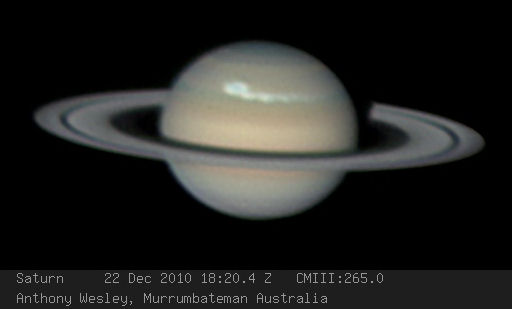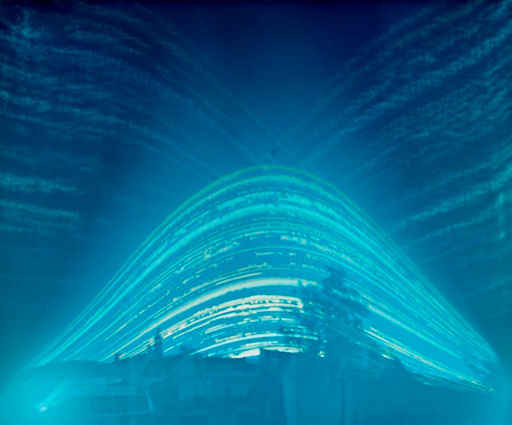Metallic photos of the sun by renowned photographer Greg Piepol bring together the best of art and science. Buy one or a whole set. They make a stellar gift. | | |
GEOMAGNETIC STORM: High-latitude sky watchers should be alert for auroras. During the early hours of Dec. 28th, the sun's magnetic field near Earth tipped south, opening a crack in Earth's magnetosphere. Solar wind poured and sparked a G1-class (Kp=5) geomagnetic storm. Observers are reporting ground currents and intensifying Northern Lights in Scandinavia.
GIANT STORM ON SATURN: Got a telescope for Christmas? Point it at Saturn. A giant storm even brighter than Saturn's rings is raging through the planet's cloudtops. "I've never seen anything like this," says veteran planetary photographer Anthony Wesley. "It's possible that this is the biggest storm on Saturn in many decades." Here it is recorded by Wesley's 16-inch telescope on Dec. 22nd:

Instruments on NASA's Cassini spacecraft are picking up strong bursts of radio static. Apparently, lightning is being generated in multiple cells across the storm front. Cassini's cameras are also beaming back fantastic images of the tempest.
"At it's current size and brightness, the storm should be visible to anyone with a mid-size scope under steady seeing," continues Wesley. "This is a great time to be a planetary photographer." [Sky maps: Dec. 29, 30, 31]
more images: from Fredy Willems of Waipahu, Hawaii; from Glenn Jolly of Gilbert, Arizona; from Christopher Go of Cebu City, Philippines; from Sadegh Ghomizadeh of Tehran, Iran; from Vincent Lao of Pasig City, Philippines
SUN IN A BEER CAN: Last July, Jan Koeman of Middelburg, the Netherlands, poked a tiny hole in an empty beer can, inserted a piece of photographic paper, and pointed the pinhole toward the sun. Six months later (Dec. 23, 2010) he extracted the paper and beheld the result:

"This is called solargraphy," explains Koeman. "Every day the sun makes a track across the photographic paper--high in the summer and low in the winter. Daily tracks are interrupted by clouds and, occasionally, absent altogether because of rainy days." It's a low-tech but beautiful way to record the seasons; browse the links below for more examples.
more solargraphy: from Becky Ramotowski of Tijeras, New Mexico; from Rijk-Jan Koppejan of Middelburg, The Netherlands;
Lunar Eclipse Photo Gallery
[NASA: "Solstice Lunar Eclipse"] [astronomy alerts]
November 2010 Aurora Gallery
[previous Novembers: 2009, 2008, 2007, 2006, 2004, 2003, 2002, 2001, 2000]
Potentially Hazardous Asteroids (
PHAs) are space rocks larger than approximately 100m that can come closer to Earth than 0.05 AU. None of the known PHAs is on a collision course with our planet, although astronomers are finding
new ones all the time.
On December 28, 2010 there were 1167 potentially hazardous asteroids.
Notes: LD means "Lunar Distance." 1 LD = 384,401 km, the distance between Earth and the Moon. 1 LD also equals 0.00256 AU. MAG is the visual magnitude of the asteroid on the date of closest approach. | | The official U.S. government space weather bureau |
| | The first place to look for information about sundogs, pillars, rainbows and related phenomena. |
| | Researchers call it a "Hubble for the sun." SDO is the most advanced solar observatory ever. |
| | 3D views of the sun from NASA's Solar and Terrestrial Relations Observatory |
| | Realtime and archival images of the Sun from SOHO. |
| | from the NOAA Space Environment Center |
| | the underlying science of space weather |

